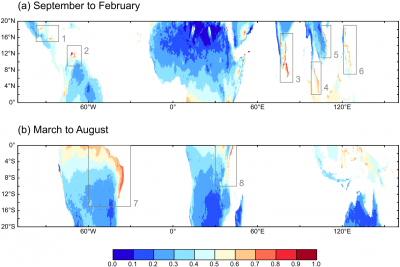Discovery of a New Regional Climate Regime
Over most tropical land, rain falls mainly during summer in the local monsoon circulation. However, in some coastal regions in the tropics, the bulk of annual precipitation occurs in autumn, after the low-level summer monsoon westerlies have abated. Examples include the Nordeste region of Brazil, southeastern India, and Sri Lanka, and coastal Tanzania. Unlike equatorial regions, these regions receive little rainfall during local spring. Such regions are present along the eastern coasts of nearly all continents, suggesting that they comprise a coherent yet previously unrecognized global phenomenon. UC Berkeley researchers who are part of the RGMA Monsoon Extremes project identified eight tropical locations that experience an ‘‘autumn monsoon’’ and showed that this unusual seasonal cycle is generated by similar mechanisms in all of these regions.
These "autumn monsoons" constitute a previously unrecognized climate regime, akin to Mediterranean climates, subtropical desert climates, or summer monsoon climates. These regions lie in westward trade winds during both spring and autumn, and the spatial structure of precipitation in these regions can be explained by their placement to the east of mountain ranges that organize moist convection on their windward sides. However, more rainfall occurs in autumn than in spring because of differences in the large-scale atmospheric stability between the equinoctial seasons, which are attributed in this study to the seasonal cycle of ocean temperatures in the remote eastern upwelling zones of the Pacific and Atlantic Oceans.
Our results imply that the timing of precipitation in these regions varies in response to large-scale factors such as remote ocean temperatures. This suggests that under anthropogenic climate change, the precipitation in these regions may depend not only on changes in the seasonal cycle of local surface temperatures and wind patterns but also on changes in the eastern ocean upwelling zones.
UC Berkeley researchers identified a new type of regional climate regime in which the main rainy season occurs during autumn. This regime is distinct from Mediterranean climates, summer monsoons, and other well-known climate types. Precipitation in autumn monsoon regions is spatially organized by orography, which provides uplift of the prevailing trade winds, but also depends on the seasonal cycle of convective stability in the global tropics. This mechanistic understanding will guide future work in understanding climate variability in a globally coherent set of regions that spans nearly all continents.

